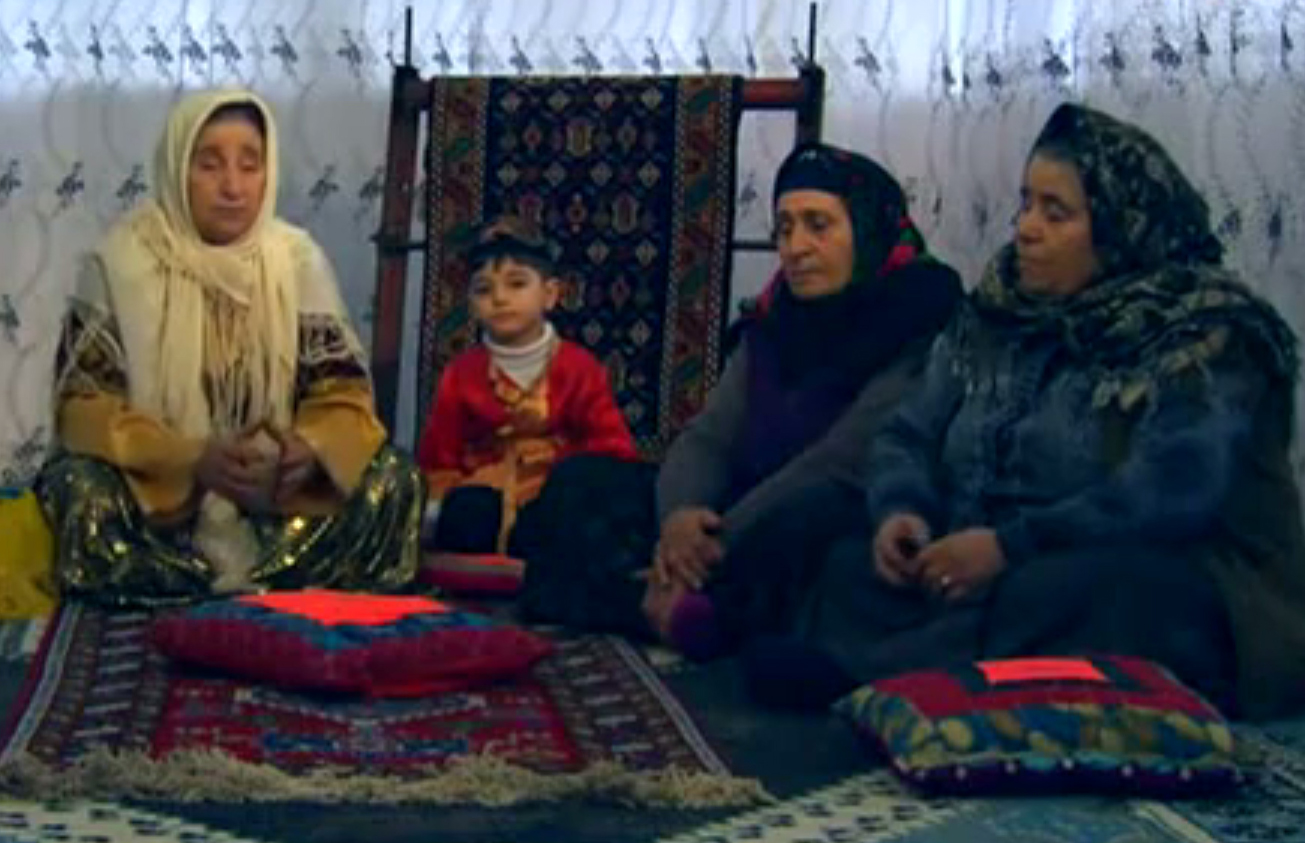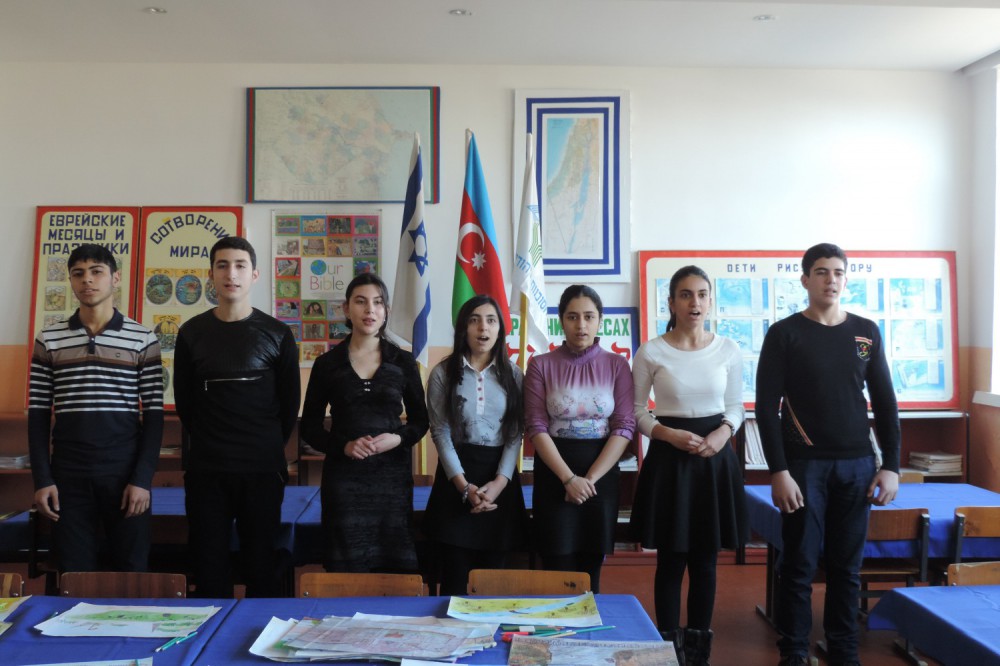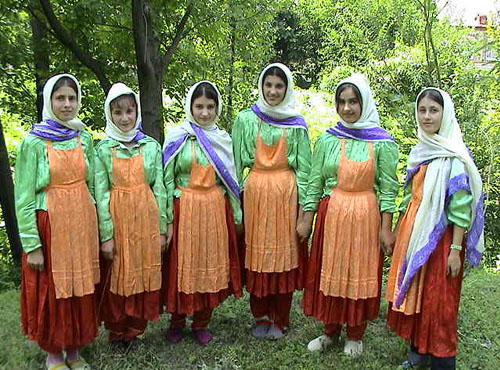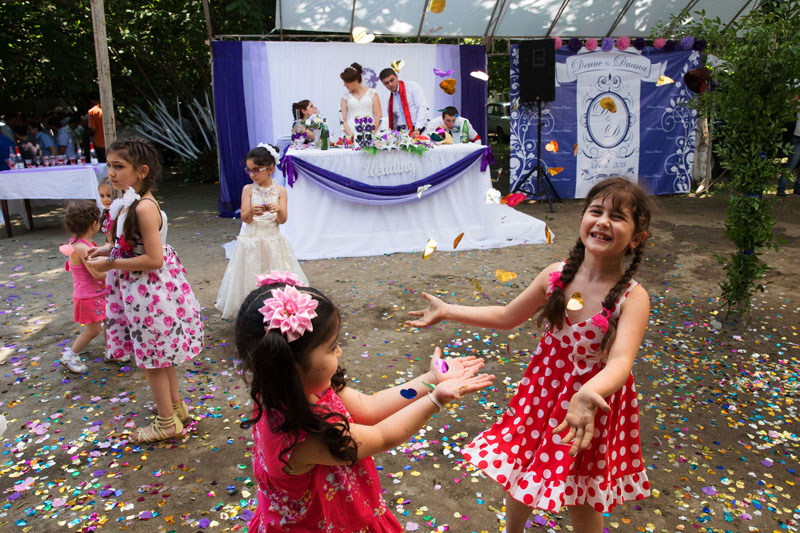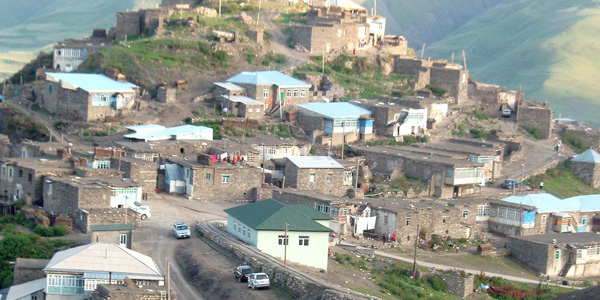Azerbaijan, on the ethnic diversity, reminds of a large-size, multi-color carpet.
Languages of the nationalities living in the territory of modern Azerbaijan mainly belong to four large language families which are the Turkic, North Caucasian, Indo-European and Kartvelian language families. However, in today's ethno-linguistic conditions in the country, dominating is the Azerbaijani language that belongs to the Oghuz group of the Turkic languages. So, the vast majority of the population of the Republic of Azerbaijan speaks this language. Modern Azerbaijani language was formed during the long-term historical development on the basis of languages of the Turkic tribes inhabiting the territory of the present Azerbaijan since the beginning of the 1st Millennium.
The North Caucasian languages in the territory of Azerbaijan are presented by the Lezgin, Avar, Tsakhur, Udi, Khinalug, Budug and Kryz languages. These languages are mainly spoken in the northeastern regions of the country. By number of speakers in the territory of Azerbaijan the most widespread North Caucasian language is the Lezgin language that belongs to the Lezgin subgroup of the Dagestani group of the North Caucasian language family.
The Udi language also belongs to the Lezgin subgroup of the North Caucasian language family (note that the question of belonging of the Udi language to the Lezgin subgroup of languages is a controversial issue). At present, the Udis mainly reside in the Nij village of Gabala region, the rest of the Udis live in the region center of Oguz.
The Lezgin subgroup of the Dagestan language group in the territory of Azerbaijan includes the Tsakhur language as well. The Tsakhurs inhabited the territory of 3 regions - Gakh (the Gum and Saribash villages), Zaqatala (Yeni Suvagil, Gezbarah, Kach and Mukhakh villages) and the Balaken region.
The "Shahdag group" of languages spoken in the north-east of Azerbaijan – Khinalug, Budug and Kryz languages – also belongs to the Lezgin subgroup of the Dagestani language group. The Khinalug language is spoken by residents of the Khinalug village in the Guba region. The Budugs live in the villages of Budug, Guney Budug and Deli Gaya of Guba region, while the Kryz - in the Elik, Jek and Haput villages of the same region.
The Avar language, mainly spoken in the territory of Zaqatala and Balaken regions, also belongs to the Avar-Ando-Didoy subgroup of the Dagestan language group of the North Caucasian language family.
The Iranian languages group of the Indo-European family of languages in the territory of Azerbaijan is presented by the Tat, Talysh and Kurdish languages.
The Tat language belongs to the southwestern subgroup of the Iranian languages, mainly spoken in several villages of the Absheron Peninsula and in the territories of Khizi, Siyazan, Shabran and Guba regions. The Tats are divided into three religious groups: Muslim Tats, Christian Tats (Monophysites) and the Tats-Judaists or Mountain Jews.
The Talysh language belongs to the north-western subgroup of the Iranian languages. This language is spoken in the southwest of Azerbaijan - in the territory of Lankaran, Astara, Lerik and Masalli regions.
The Kurdish language belongs to the western subgroup of the Iranian languages. The Kurdish language is spoken in the territories of Lachin, Gubadli, Kalbajar and some other southwest regions of Azerbaijan.
The Indo-European family of languages in the territory of Azerbaijan is presented by the Russian and Armenian languages.
The Russian language belongs to the North Slavic subgroup of Slavic group of the Indo-European family of languages. Speakers of the Russian language in Azerbaijan mainly reside in the cities of the Republic, first of all, in Baku.
The Armenian language represents a separate group of the Indo-European languages, and is spoken in several regions of the mountainous part of Karabakh.
The Kartvelian language family in Azerbaijan is presented by the Georgian language. Speakers of this language are the Muslim and Christian Ingiloys. They are inhabited mainly in the Gakh, Zaqatala and Balaken regions of the country.
The Republic of Azerbaijan has an ethnically diverse population. Representatives of more than 100 ethnos live in the country.Azerbaijanis constitute the majority of the population in Azerbaijan (over 90%) that amount to 9 million 705 thousand people (as of the beginning of 2016). Approximately, more than 50 million Azerbaijanis live in the world today. Millions of Azerbaijanis compactly living in Iran, Georgia and Dagestan are the ancient inhabitants of these areas. 30 million of Azerbaijanis live only in Iran. Hundreds of thousands of Azerbaijanis who were indigenous people of present Armenia in the 20th century repeatedly were deported from these territories. Lots of Azerbaijanis who at various times moved from Azerbaijan, lives in the CIS countries – in Russia, the republics of Central Asia, Kazakhstan, Ukraine, etc. and also in the European and American continents.
Language of the Azerbaijanis belongs to the southwestern or the Oguz group of Turkic languages. This language is very close to the Turkish, Turkmen and Gagauz languages, and also to the language of the Crimean Tatars. The Azerbaijani language has historically played a role of communication not only within the country, but also among the peoples living in all the Caucasus and in the Asia Minor. In the 19th century, outstanding writers and travelers of Europe and Russia (E. Reclus, A. Bestuzhev-Marlinsky, F. Bodenstedt, M. Lermontov, etc.) have highly appreciated the role of Azerbaijani language in the region. The Russian writer A. Bestuzhev-Marlinsky wrote that the Azerbaijani language of the Caucasus slightly differs from the Turkish language. Just as knowing the French you can walk around all Europe, in the same way, knowing the Azerbaijani language, you can walk across all Asia.
It should be certainly noted the binding role of Azerbaijanis among the nations living in this country. Undoubtedly, this phenomenon stems from the national mentality of Azerbaijanis, their tolerance towards cultures of other peoples.
Along with Azerbaijanis, representatives of a number of other small peoples and ethnic minorities live in the republic. The Tats, Talyshes, Kurds, Mountain Jews belonging to the Iranian languages group of the Indo-European family of languages, the Lezgins, Avars, Udis, Tsakhurs, belonging to the Avar-Ando-Tsez subgroup of the East Caucasian (Dagestani) group of the Caucasian family of languages, the peoples of “Shahdag group” (Khinalug, budug, Kryz), the Ingiloys belonging to the Kartvelian group of the Caucasian languages family and speaking on an Ingiloy dialect of Georgian language, live here. Besides, the Russians who have settled in the 30s of the 19th century and belonging to the East Slavic languages group, and also since 50-60s of the 20th century the Meskhetian Turks live in Azerbaijan.
The territorial unity, similar socio-economic, geographical and historical conditions have led to the formation of the common features of life and culture, customs and traditions of Azerbaijanis and small peoples.Undoubtedly, in this, an important role was played by intensive trade-economic and ethno-cultural relations among the peoples.
Throughout history there were established harmonious, peaceful, inter-ethnic relations among the peoples living in Azerbaijan, and there was no ground for the ethnic conflicts and tension.The common and peculiar features of traditional life and culture of the peoples living in Azerbaijan are in close unity and complement each other. At the same time, each people, irrespective of the number of his representatives, have specific and local culture. The cultural centers functioning in the Republic of Azerbaijan plays an important role in revival and preservation of national customs and traditions of these people. These peoples take an active part in socio-political life of the Republic.
According to the population census of Azerbaijan conducted from April 13 to April 22, 2009, the number of Talyshes in the territory of the republic has amounted to 112 thousand people.
They, generally compactly live in the southern regions of the republic – in Astara, Lankaran, Masalli and Lerik. Their religion is Islam. The important role in ethno-genesis of Talyshes was played by the Kadus tribes living in Atropatena. This also is stated in Strabo's “Geography”. Traditional occupation of the Talyshes is agriculture and cattle breeding. In the past, rice growing was another primary branch of economy.The Tats (25.2 thousand people, 2009). They live generally in Shabran, Guba, Shamakhi and Ismailli regions of the country. The Tats are Muslims. According to A. Bakikhanov and other researchers, the ancestors of the Tats have been moved to Azerbaijan in the 4th-6th centuries by Sassanid Shahs. Traditional occupations of the Tats are agriculture and gardening, and also carpet-weaving. Their family-household relations are approximately the same as that of Azerbaijanis.
The Kurds (6.3 thousand people, 2009). Before the Armenian occupation the Kurds mainly lived in the Lachin and Kalbajar regions. At present, they have resettled in many cities and regions of Azerbaijan. The Kurds have come to Azerbaijan, generally in the 16th century during the Ottoman-Iranian wars. The Gulistan (1813) and Turkmenchay (1828) treaties have also led to strengthening of migration of the Kurds to Azerbaijan. The cattle breeding (especially, sheep breeding) was traditional occupation of Kurds. With the transition in the late 19th century of the Kurds to settled life, also was developed agriculture. Weaving, in particular, the carpet-weaving and other national crafts are also widespread among them.
The Jews (9.1 thousand people, 2009). The Mountain Jews living in Azerbaijan have settled in the Krasnaya Sloboda (Red Settlement), Guba region, in the center of Oguz region and in Baku. The Red Settlement is the biggest settlement of compacted residence of the Jews. In the documents of the population census in Azerbaijan conducted in 1999, the data on Mountain Jews have been provided in composition of data on the European Jews (Ashkenazi). The Mountain Jews who have once left their historical Homeland, and arrived to Iran have acquired the Tat language here, and have preserved the main essence of Judaic religion. During the Sassanid period they have been moved to the Northern Azerbaijan.
Unlike the European Jews who have settled in Azerbaijan since the early 19th century, at first, the idolatry and then Islam had certain impact on religious views of Mountain Jews. They have acquired many customs and traditions of Azerbaijanis. Agriculture, small trade, weaving and other national crafts were traditional occupations of the Mountain Jews.
Migration of the European Jews from Russia, Ukraine, Belarus and Poland to Azerbaijan began in the early 19th century. Their migration to Baku increased following the development of the oil industry since the 70s of the 19th century. Most of the European Jews live in the cities (in particular, in Baku).
Most of Lezgins (180.3 thousand people, 2009) live in the Gusar region of Azerbaijan. There are Lezgin villages in the Guba, Khachmaz, Ismailli and Gabala regions as well. According to experts, one of the ancestors of Lezgins was the ancient Albanian tribe called “Legs”. The Lezgins are Muslims. Traditional occupations of Lezgians are agriculture, cattle-breeding and national crafts (weaving, including carpet-weaving, tinning, felt making, etc.).
The Tsakhurs (12.3 thousand people, 2009) have settled in Zaqatala, Gakh and Balaken regions of the Republic. Tsakhurs are one of the ancient inhabitants of the Caucasian Albania. In the 15th century, Tsakhurs have left Southern Dagestan and have settled in the Azerbaijani lands, suitable for agriculture. In the mid-19th century the Tsakhurs were a part of the Ilisu Sultanate. Since that time their ethno-cultural and commercial relations with Azerbaijanis were strengthened. Tsakhurs from the ethnic point of view are very close to Azerbaijanis. Traditional occupations of Tsakhurs are the cattle breeding and agriculture.
Avars (49.8 thousand people, 2009) live in the Balaken and Zaqatala regions of the Republic. According to a number of authors, the “Didoys” mentioned in the works of Gaius Plinius were the ancestors of modern Avars. The Avars have come to Azerbaijan from Dagestan at 15-17 centuries. They speak the Ansukh dialect of Avar language. They are Muslims. Traditional occupations of Avars are agriculture, cattle breeding and workmanship.
Udis (3.8 thousand people, 2009) live in the settlement of Nij of Gabala region and in the center of Oguz region. The Nij village is the largest residence of Udis. Udis are one of ancient local nationalities of Azerbaijan. Information on Udis is provided even in the works by Herodotus, Plinius and Strabo. Udis are the descendants of the “Uti” tribe living in the Caucasian Albania.
As a result of the policy pursued by Armenians throughout centuries, a part of Udis (living in the settlement of Nij) were Gregorianized by Armenians and the other part (living in Oguz) has undergone the influence of the Georgian Orthodox Church and became Georgians. Traditional occupation of Udis is agriculture. In the past, they were also engaged in silkworm breeding and national crafts (woodcarving, weaving, etc.).
The Khinalug, Budug and Kryz peoples, in historical and ethnic literature known as the “peoples of Shahdag group”, live in Guba region in the villages located at the foothills of Mount Shahdag. The Khinalugs live in a single village Khinalug, the Budugs – generally in the village Budug, and the Kryz – in the village of Kryz. Besides, the Kryz and the Budugs live in several neighboring villages. Approximately, the number of the Khinalugs makes 2.2 thousand, the number of Budugs – 15 thousand, and the number of Kryz – 4.4 thousand people. Still in the 40s of the 19th centuries a part of the Budugs and Kryz moved to the flat regions of Azerbaijan where they built the hamlet type of settlements. Major activity of these people is sheep breeding.
The Ahiska Turks (or Meskheti Turks, 38 thousand people, 2009). The first large group of Meskheti Turks has arrived to Azerbaijan in 1958. It were the Ahiska Turks banished in 1944 from their historical homeland – Ahiska, Adigun, Akhalkalaki (Georgia) and other neighboring regions to the Central Asia and Kazakhstan. The Fergana events of 1989 led to the second migration of Meskheti Turks to Azerbaijan. The origin common with Azerbaijanis, common language, proximity of customs and traditions have created favorable conditions for their adaptation in Azerbaijan. Traditional occupations of Meskheti Turks are gardening and agriculture. In Saatli, Sabirabad and Beylagan regions of Azerbaijan they are engaged generally in cotton breeding.
The Ingiloys (9.9 thousand people, 2009) are divided into the Muslim Ingiloys and Christian Ingiloys (the Georgian Orthodox Church). The Muslim Ingiloys live in the Mosul and Aliabad villages of Zaqatala region, in the Ititala village of Balaken region, while the Christian Ingiloys - in 9 villages of Gakh region. In ancient times, the territory where Ingiloys lived was called Kambisena (Ereti, Hereti), the main population of which consisted of the tribes “Er” and “Gel”, who were considered to be Ingiloys’ ancestors. An Albanian church functioned there. A part of Ingiloys are the descendants of the Albanian tribes who later have forcibly accepted the Georgian religion. Traditional occupations of Ingiloys are agriculture, gardening and partially animal husbandry. In the past, among them also was widespread silkworm breeding and rice growing.
Arrival of the Russians (119.3 thousand people, 2009) in Azerbaijan occurred mainly in the 30-40s of the 19th century – the period after occupation of Northern Azerbaijan by Russia. At this time, for successful implementation of colonial policy in Azerbaijan, thousands of Russians have been moved from the central provinces of Russia to the Caucasus, including Azerbaijan. These people were generally the sectarians (Doukhobors, Molokans, Subbotniks, etc.) persecuted by the official Russian Orthodox Church. The first Russian villages in Azerbaijan have appeared in the 30-40s of the 19th century in the Lankaran (Prishib, Nikolaevka, Astrakhanovka), Shamakhi (Khilmilli, Maraza) and Guba uyezds (Altiagaj, etc.). The second stage of the Russians’ arrival in Azerbaijan, in particular, in Mugan happened in the 20s of the 20th century. At present, most of the Russians live in the cities.
Armenians (120.7 thousand, 1999) live mainly in the mountainous part of Karabakh. Their mass resettlement from Iran and Turkey to this region began in the 20-30s of the 19th century. The Armenian language belongs to the Indo-European language family. The Armenians are Christian Monophysites. It was impossible to conduct a population census in 2009 in the territory of the former Nagorno-Karabakh Autonomous Oblast occupied as a result of the territorial claims of Armenia against Azerbaijan.
According to population census of 2009, 25.2 thousand Tatars and 21.5 thousand Ukrainians live in Azerbaijan.
Besides, more than 10 thousand representatives of other nationalities live in the territory of the country.
In Azerbaijan, representatives of all nationalities, small peoples, ethnic minorities and ethnic groups live together in harmony, in the spirit of mutual understanding and respect.


